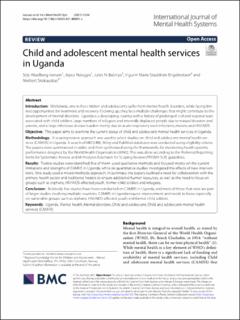| dc.contributor.author | Akselberg, Silje Martine | |
| dc.contributor.author | Nalugya, Joyce | |
| dc.contributor.author | Babirye, Juliet Ndimwibo | |
| dc.contributor.author | Engebretsen, Ingunn Marie Stadskleiv | |
| dc.contributor.author | Skokauskas, Norbert | |
| dc.date.accessioned | 2022-02-28T14:39:39Z | |
| dc.date.available | 2022-02-28T14:39:39Z | |
| dc.date.created | 2021-10-01T09:51:13Z | |
| dc.date.issued | 2021 | |
| dc.identifier.citation | International Journal of Mental Health Systems. 2021, 15 1-12. | en_US |
| dc.identifier.issn | 1752-4458 | |
| dc.identifier.uri | https://hdl.handle.net/11250/2981811 | |
| dc.description.abstract | Abstract Introduction: Worldwide, one in five children and adolescents suffer from mental health disorders, while facing limited opportunities for treatment and recovery. Growing up, they face multiple challenges that might contribute to the development of mental disorders. Uganda is a developing country with a history of prolonged civil and regional wars associated with child soldiers, large numbers of refugees and internally displaced people due to natural disasters and unrests, and a large infectious disease burden mainly due to acute respiratory tract infections, malaria and HIV/AIDS. Objective: This paper aims to examine the current status of child and adolescent mental health services in Uganda. Methodology: A scoping review approach was used to select studies on child and adolescent mental health services (CAMHS) in Uganda. A search of MEDLINE, Wiley and PubMed databases was conducted using eligibility criteria. The papers were summarized in tables and then synthesized using the Frameworks for monitoring health systems performance designed by the World Health Organisation (WHO). This was done according to the Preferred Reporting Items for Systematic Review and M-Analyses Extension for Scoping Review (PRISMA-ScR) guidelines. Results: Twelve studies were identified; five of them used qualitative methods and focused mostly on the current limitations and strengths of CAMHS in Uganda, while six quantitative studies investigated the effects of new interventions. One study used a mixed-methods approach. In summary, the papers outlined a need for collaboration with the primary health sector and traditional healers to ensure additional human resources, as well as the need to focus on groups such as orphans, HIV/AIDS-affected youth, former child soldiers and refugees. Conclusion: Relatively few studies have been conducted on CAMHS in Uganda, and most of those that exist are part of larger studies involving multiple countries. CAMHS in Uganda require improvement and needs to focus especially on vulnerable groups such as orphans, HIV/AIDS-affected youth and former child soldiers. Keywords: Child and adolescent; Child and adolescent mental health services (CAMHS); Mental disorders; Mental health; Uganda. | en_US |
| dc.language.iso | eng | en_US |
| dc.publisher | BMC | en_US |
| dc.rights | Navngivelse 4.0 Internasjonal | * |
| dc.rights.uri | http://creativecommons.org/licenses/by/4.0/deed.no | * |
| dc.title | Child and adolescent mental health services in Uganda | en_US |
| dc.type | Journal article | en_US |
| dc.type | Peer reviewed | en_US |
| dc.description.version | publishedVersion | en_US |
| dc.source.pagenumber | 1-12 | en_US |
| dc.source.volume | 15 | en_US |
| dc.source.journal | International Journal of Mental Health Systems | en_US |
| dc.identifier.doi | 10.1186/s13033-021-00491-x | |
| dc.identifier.cristin | 1941926 | |
| dc.relation.project | Norges forskningsråd: 285489 | en_US |
| cristin.ispublished | true | |
| cristin.fulltext | original | |
| cristin.qualitycode | 1 | |

